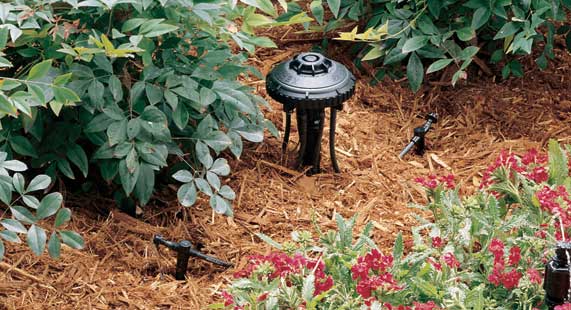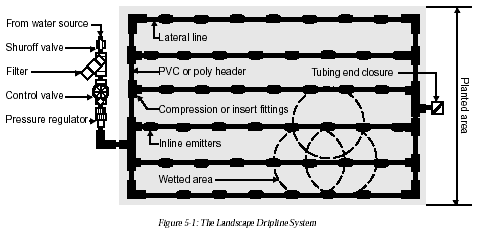
 |
Converting to Drip Irrigation
|
Retrofitting Spray Irrigation Systems to Drip Irrigation
In the summer of 2001 the southern portion of Vancouver Island was hit with extremely low reservoir levels. In the ensuing months in a scramble to save water, watering grass was 100% banned. However, all was not lost, since gardens will still allowed to be watered with drip irrigation only.
Retrofitting spray-style zones to drip zones is not only possible, it is a fantastic idea that saves water and waters plants in the most efficient automatic form possible today. Drip irrigation in the landscape can take a number of forms: for gardens with few shrubs and perennials planted throughout, "point-source" drip irrigation is usually best suited. This particular design uses one or two emitters per plant, their output sized relatively with other plants on that drip zone so that large shrubs receive more water than smaller ones.
Another form of drip irrigation that is more commonly used for more densely planted shrub, groundcover and perennial plantings is a system of liner grid drip-line installation. In this system, 1/2" tubing with drip emitters spaced at 12" or 18" intervals is buried just below the surface. The drip tubing is installed in rows, usually 12" or 18" apart running parallel until the entire garden is covered with a "grid" of tubing.

Another option available for conversion of spray-style patterns are micro spray irrigation systems. These sprays are similar to the normal spray-style patterns, except on a much smaller level, with a spray pattern radius of 1' - 2'. Also available in this class of sprinklers are multiple stream bubblers, the difference being they usually have a 3' - 4' a radius pattern and they emit multiple streams rather than fan-style sprays. Micro irrigation is usually used for dense plantings with minimal root structure, like annuals.
Whether you decide to use point-source, gridline, or micro irrigation styles, converting to drip irrigation system for your garden areas is a popular change that is sure to save you water!
Want to learn more? Refer to Rain Bird's Low Volume Landscape Irrigation Design Manual, available here in .pdf format: http://www.rainbird.com/pdf/turf/d39030d.pdf.

© Copyright
University Sprinkler Systems Inc.
University Sprinklers and www.universitysprinklers.com are registered trademarks of University Sprinkler Systems Inc.
Website Design by Rainmaker Marketing & Design. 604-739-9476
